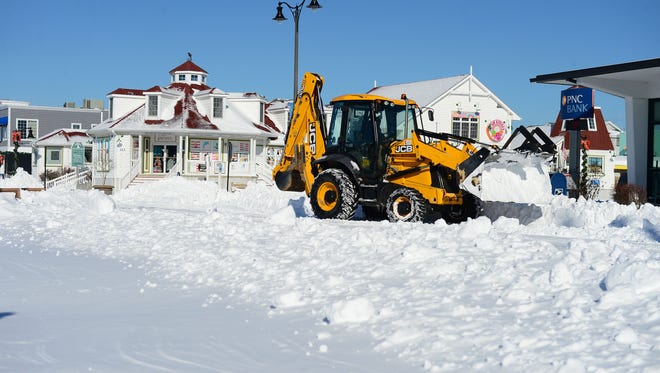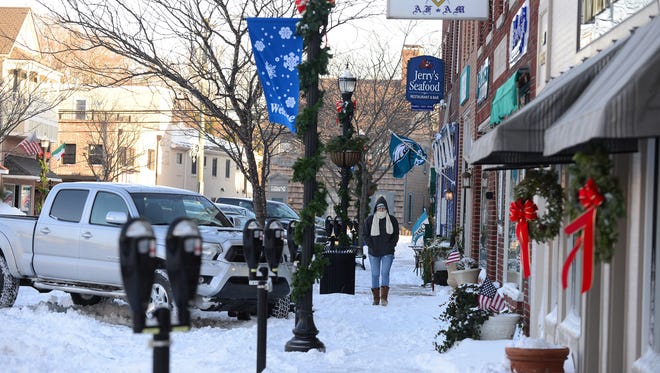Snow aftermath: How Shore towns and beaches fared amid blizzard, 25-foot waves
 Gray Hughes
Gray Hughes
Winter storms similar to the snow bomb cyclone last week are a large culprit for beach erosion in Delaware and Maryland.
Despite hurricane wind gusts and rough surf, the most recent winter storm hardly made a dent in the shoreline, officials say.
A low tide and shift in the winds when the most ferocious part of the storm circled over Delmarva spared the beaches from significant complications, according to the National Weather Service.
"Luckily, the winds switched from the northeast to northwest," said Woody Vickers, public works construction manager for Ocean City. "There was some high surf, but it didn’t create any major issues on the beach."
Three Delaware beach towns — Fenwick Island, South Bethany Beach and Bethany Beach — are set to have replenishment begin in the spring, Gordon said.
"The beach didn't suffer at all," said Jack Gordon, Bethany Beach mayor. "The beach is in the state that it was at the end of last summer."

In Rehoboth Beach and Ocean City — which just completed nourishment projects in 2017 — officials said projects held up well with little to no damage.
Ocean City completed its beach replenishment project in mid-December, and the town was very thankful for the project, said Woody Vickers, public works construction manager for Ocean City.
Bethany Beach officials weren't worried, Gordon said, because the storm was not a typical nor'easter, the type of storm that wreaks havoc on Delmarva beaches.
This snow bomb cyclone differs from a typical nor'easter because it was a storm system with a rapidly decreasing pressure area and "explosive" strength.
But the storm could have had a different result for the beaches if not for a few environmental factors, according to Jeff Orrock, meteorologist with the National Weather Service in Wakefield, Virginia.
There are 12 to 15 nor'easters a year that typically cause beach erosion, but this time there wasn't any erosion because the area was in a low tide cycle, Orrock said.
"By the time the nor’easter intensified, the winds were blowing northwest, blowing the water offshore," he said. "We didn’t have any strong offshore flow. We didn’t have any tidal flooding issues."
READ MORE: Environmental board denies appeal to halt Rehoboth Beach outfall
If it had been high tide when the winds were blowing toward the beach, Orrock said, it would have been a different story because waves were 25 feet high.
The little erosion that did occur, Orrock said, was caused by wave action rather than sand being taken out with the tide.
Even with the threat for more nor'easters to hit this winter, Gordon said officials aren't too worried that anything catastrophic will occur with replenishment relief on the way.
"We will have nor'easters but nothing we are overly concerned about," Gordon said. "We are happy that we are in line to get beach replenishment though."
Dealing with cleanup and costs

While Salisbury did not have the coast to worry about, Bill Sterling, traffic superintendent for the city, said officials did have their own unique challenges.
Salisbury salted 510 miles of streets and plowed 2,241 miles, and cleared 19 parking lots, Sterling said — all while battling blizzard conditions at times.
"We have seven snow routes that are Priority 1 and the snow was blowing so hard Thursday morning when we were plowing those routes it was difficult to retrace the routes," he added. "By having to clear our snow routes first, it delayed the time we could get into those residential communities."
In total, Salisbury workers put in 2,078 hours — very much into overtime, Sterling said.
After this latest storm, Rehoboth Beach and other towns had to focus mostly on cleaning up the streets to make sure they were passable.
"We have to replenish salt, so that's the first thing we keep in mind," said Mike Peterman, streets department supervisor for Rehoboth Beach. "We also have to go down the streets to the curbs to get closer to the residences. We need to make it able to be passable for emergency situations."
These storms cause workers to go into overtime to help keep the streets clean, costing coastal towns thousands of dollars. Towns also have to prioritize what gets cleaned up first.
In Rehoboth Beach, the fire and police departments are right on Rehoboth Avenue, meaning that street needs to be cleaned first, said Krys Johnson, communication specialists for the city.
"We had people who work at Beebe and live in the city contact us, so we were able to clear the snow in front of their houses so they can get to work," she added.
READ MORE: Somerset superintendent has fun with snow, school closure announcements
Rehoboth Beach employees were running 12-hour days and nights for three straight days, Peterman said.
This most recent storm, Johnson said, was much worse than a similar storm that hit in January 2017.
"Due to high wind, there were drifts that raised snow levels in the city substantially," she said. "This resulted in large piles of snow for the streets department crew to remove."
That storm last year cost the Rehoboth Beach $12,000, she said, adding she expects this year's storm to cost more.
Bethany Beach doesn't track how much it spends on snow removal, Gordon said, but this storm created more mess than last year's.
"We had nothing last year that affected us like this one," he said. "Last year, there weren't any problems that came from the storm — and this year presented no different problems — but there was a lot more snow this time."
Ocean City, too, had crews running from when the storm hit until Friday at 5 p.m., Vickers said, with 10-person crews on Saturday and Sunday.
One of the biggest issues Ocean City had, Vickers said, was with the severity and the amount of snow because it is hard to find areas to put the snow that won't impact residents.

"(The State Highway Administration) does Coastal Highway, and they are constantly plowing it," he added. "That allowed us to get the side streets open."
In Bethany Beach, even when the town was closed on Thursday and Friday, crews were still able to plow the roads, Gordon said.
Now, he said, the roads are under control.
"We still have some snow on them but they have all been plowed," he said. "You can get in and out easily. The town had no damage, and we came through it quite well. Traffic is flowing well on main and side streets. It was handled real well."
On Twitter @hughesg19